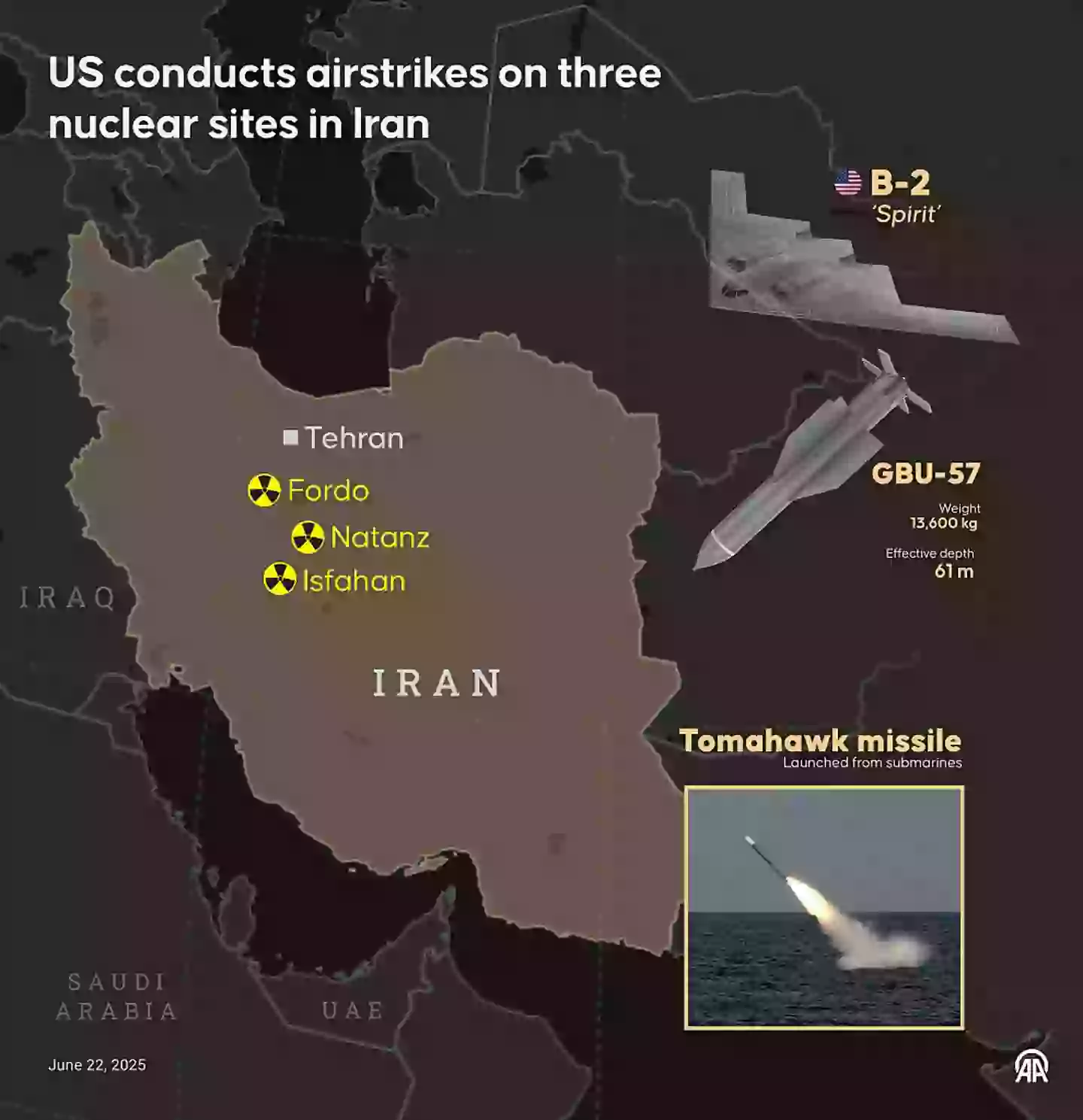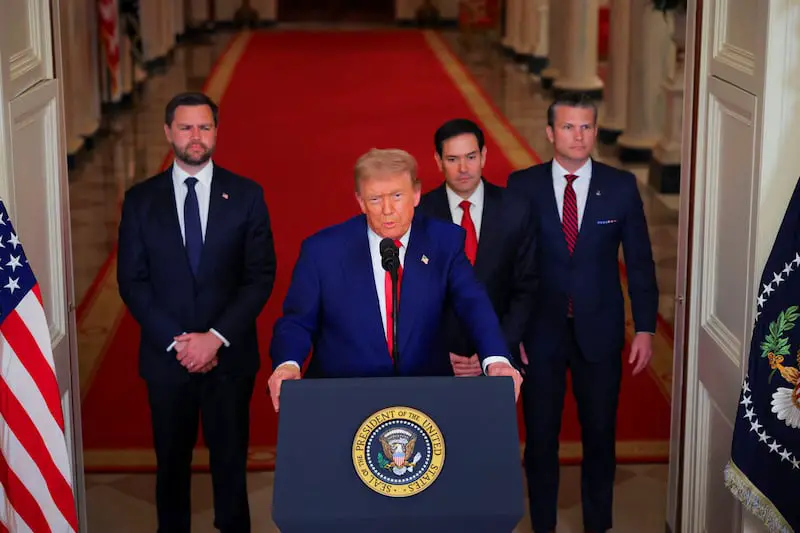United States Conducts Military Strikes Against Iranian Nuclear Infrastructure
Trump Administration Authorizes Unprecedented Attack on Three Key Nuclear Facilities
Washington, D.C. — In a dramatic escalation of Middle Eastern tensions, the United States military executed coordinated airstrikes against three critical Iranian nuclear facilities on Saturday evening, marking the most significant direct military confrontation between the two nations in decades. President Donald Trump announced the operation via social media and later addressed the nation, describing the mission as a decisive response to Iran’s nuclear ambitions.

Operation Details and Scope
The strikes, which commenced at approximately 7:50 PM Eastern Time on June 21, 2025, targeted Iran’s most strategically important nuclear installations: the Fordow Fuel Enrichment Plant, the Natanz Nuclear Facility, and the Isfahan Uranium Conversion Facility. These sites represent the cornerstone of Iran’s nuclear program and have been subject to international scrutiny for their potential dual-use capabilities in both civilian energy production and weapons development.

According to defense officials familiar with the operation, the United States deployed B-2 Spirit stealth bombers equipped with Massive Ordnance Penetrator (MOP) bunker-busting bombs, each weighing approximately 30,000 pounds. These specialized munitions are specifically designed to penetrate heavily fortified underground installations, making them uniquely suited for targeting Iran’s deeply buried nuclear infrastructure.
The Fordow facility, constructed within a mountain complex approximately 100 meters underground, received particular attention during the operation. Military analysts have long considered this installation among the most challenging targets due to its natural geological protection and engineered fortifications. The facility’s location and construction were deliberately designed to withstand conventional military attacks, necessitating the use of the most advanced penetrating weapons in the U.S. arsenal.
Presidential Statement and Strategic Objectives
In his televised address to the nation, President Trump articulated the administration’s rationale for the unprecedented military action. “Our objective was the destruction of Iran’s nuclear enrichment capacity and a stop to the nuclear threat posed by the world’s number one state sponsor of terror,” Trump declared during the White House briefing. “Tonight, I can report to the world that the strikes were a spectacular military success.”
The President further emphasized the thoroughness of the operation, stating that “Iran’s key nuclear enrichment facilities have been completely and totally obliterated.” Trump characterized Iran as “the bully of the Middle East” and issued a stark ultimatum, warning that failure to pursue peace would result in “future attacks that will be far greater and a lot easier.”
The President’s remarks reflected a significant shift in U.S. foreign policy toward Iran, representing the most direct military intervention in the ongoing regional conflict. Trump had previously indicated his reluctance to involve American forces in Middle Eastern conflicts while simultaneously maintaining that Iran must never be permitted to acquire nuclear weapons capability.
International Response and Diplomatic Implications
The military action has generated immediate international reactions, with various stakeholders expressing both support and concern regarding the escalation. Israeli officials, who have been conducting their own military operations against Iranian targets, welcomed the U.S. intervention. Prime Minister Benjamin Netanyahu praised Trump’s “bold decision,” stating that “history will record that President Trump acted to deny the world’s most dangerous regime, the world’s most dangerous weapons.”
Iranian Foreign Minister Seyed Abbas Araghchi responded with strong condemnation, characterizing the attacks as “outrageous” and warning of “everlasting consequences.” In a statement posted on social media, Araghchi declared that “each and every member of the UN must be alarmed over this extremely dangerous, lawless and criminal behavior.” The Iranian government has historically maintained that its nuclear program serves exclusively peaceful purposes, despite international skepticism regarding its uranium enrichment activities.
Technical Assessment and Damage Evaluation
The International Atomic Energy Agency (IAEA), the United Nations’ nuclear watchdog organization, conducted preliminary assessments of the strike locations. In an initial statement, the IAEA reported “no increase in off-site radiation levels” at the targeted facilities, suggesting that any radioactive materials present at the sites remained contained. This finding indicates either successful containment of nuclear materials or the possibility that sensitive materials had been relocated prior to the attacks.
The IAEA’s statement noted that the organization would “provide further assessments on the situation in Iran as more information becomes available,” acknowledging the complexity of evaluating damage to heavily fortified underground installations. The absence of radiation leaks represents a significant consideration for regional safety and environmental impact.
Iran’s Nuclear Program and Weapons Potential
Understanding the strategic significance of these strikes requires examination of Iran’s nuclear capabilities and trajectory toward potential weapons development. Iran has been systematically enriching uranium to levels far exceeding requirements for civilian nuclear power generation, raising international concerns about military applications.
Natural uranium contains approximately 0.7 percent of the fissile isotope uranium-235, which must be enriched to roughly 3.5 percent for use in nuclear power reactors. However, Iranian facilities have been producing uranium enriched to 60 percent purity, representing a substantial step toward weapons-grade material, which typically requires 90 percent enrichment.
According to assessments by the Institute for Science and International Security, a prominent non-profit monitoring organization, Iran’s current stockpile of highly enriched uranium could theoretically support the production of nearly a dozen nuclear weapons within a single month if further enriched to weapons-grade levels. The organization’s June 9, 2025 report provided alarming projections regarding Iran’s breakout timeline.
Breakout Timeline Analysis
The Institute’s analysis revealed particularly concerning capabilities at the Fordow facility, which could produce weapons-grade uranium in an extraordinarily compressed timeframe. According to their assessment, “Iran could produce its first quantity of 25 kg of weapons-grade uranium in Fordow in as little as two to three days.”
The report projected escalating production capabilities, estimating that combined operations at Fordow and the Natanz Fuel Enrichment Plant could generate sufficient weapons-grade uranium for eleven nuclear weapons within the first month of dedicated production. This timeline would extend to fifteen weapons by the second month, nineteen by the third month, twenty-one by the fourth month, and twenty-two by the fifth month.
These projections underscore the strategic imperative that likely influenced the decision to conduct military strikes, as the window for preventing Iranian nuclear weapons capability was rapidly narrowing.
Military Assets and Operational Planning
Intelligence sources indicate that the operation involved careful preparation and coordination. U.S. Air Force B-2 Spirit bombers were observed departing American military installations over recent days, routing toward Diego Garcia, a strategic island base in the Indian Ocean jointly operated by the United States and United Kingdom. This facility serves as a crucial staging point for long-range operations in the Middle East and South Asia.
The selection of targets reflects sophisticated intelligence gathering and strategic planning, focusing on facilities that represent the core of Iran’s enrichment infrastructure. The Natanz facility, which houses thousands of centrifuges for uranium enrichment, the Isfahan complex responsible for uranium conversion processes, and the heavily protected Fordow installation collectively constitute Iran’s primary nuclear production capability.
Regional Security Implications
The U.S. military intervention represents a significant escalation in the broader Middle Eastern conflict that has intensified over recent weeks. Israeli forces have been conducting sustained operations against Iranian military assets, focusing on degrading Iran’s missile capabilities and nuclear infrastructure. The American decision to join this campaign directly transforms the nature of the conflict from a regional dispute to a confrontation involving global superpowers.
Security experts anticipate potential Iranian retaliation against American interests in the region, including military installations, diplomatic facilities, and allied nations. Law enforcement agencies across the United States have heightened security measures at sensitive locations, reflecting concerns about potential domestic threats.
Conclusion
The United States’ military strikes against Iranian nuclear facilities mark a watershed moment in Middle Eastern geopolitics and nuclear non-proliferation efforts. President Trump’s decision to authorize direct military action represents the culmination of decades of diplomatic efforts to prevent Iranian nuclear weapons development and reflects the administration’s assessment that peaceful resolution had become impossible.
The international community now faces the challenge of managing the consequences of this escalation while working to prevent broader regional conflict. The effectiveness of the strikes in permanently degrading Iranian nuclear capabilities remains to be determined, as does Iran’s response to this unprecedented American military intervention.
As the situation continues to evolve, the global implications of this confrontation will likely reshape Middle Eastern security dynamics and international approaches to nuclear non-proliferation for years to come.

Lila Hart is a dedicated Digital Archivist and Research Specialist with a keen eye for preserving and curating meaningful content. At TheArchivists, she specializes in organizing and managing digital archives, ensuring that valuable stories and historical moments are accessible for generations to come.
Lila earned her degree in History and Archival Studies from the University of Edinburgh, where she cultivated her passion for documenting the past and preserving cultural heritage. Her expertise lies in combining traditional archival techniques with modern digital tools, allowing her to create comprehensive and engaging collections that resonate with audiences worldwide.
At TheArchivists, Lila is known for her meticulous attention to detail and her ability to uncover hidden gems within extensive archives. Her work is praised for its depth, authenticity, and contribution to the preservation of knowledge in the digital age.
Driven by a commitment to preserving stories that matter, Lila is passionate about exploring the intersection of history and technology. Her goal is to ensure that every piece of content she handles reflects the richness of human experiences and remains a source of inspiration for years to come.
